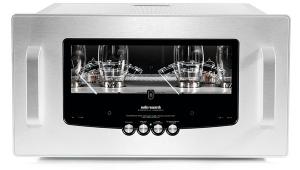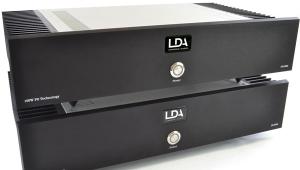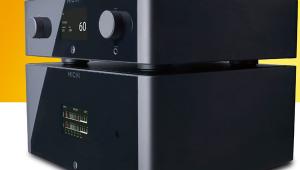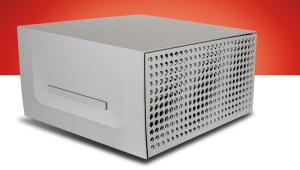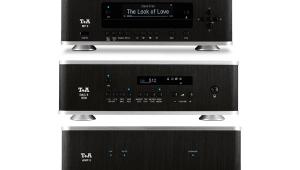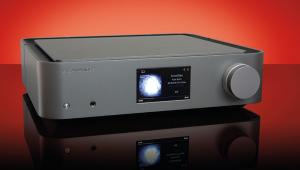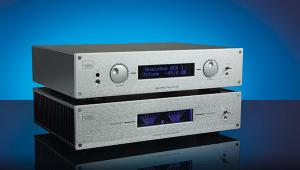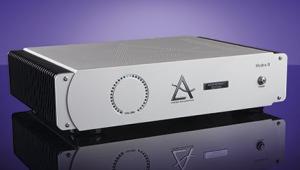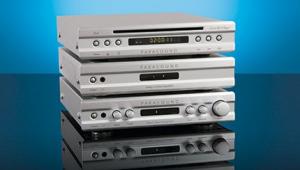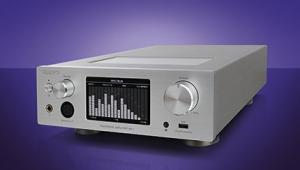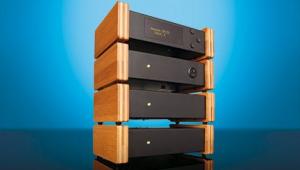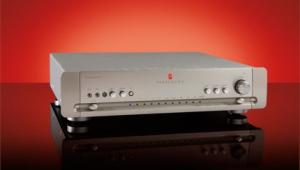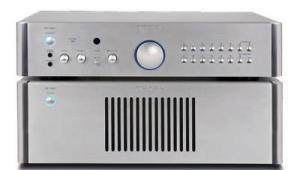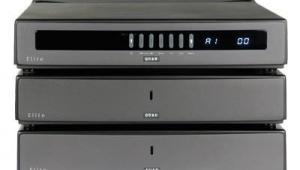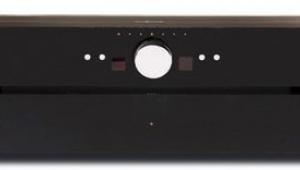Cambridge Audio Azur 851D - £1,000
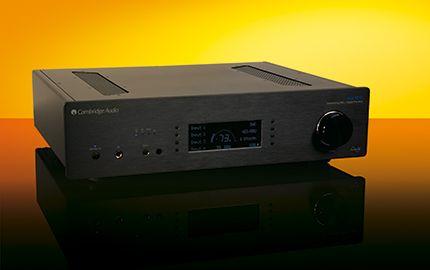
Somewhere around the turn of the millennium, hi-fi started getting interesting again – with DVD-Audio and SACD arriving, MP3 going gangbusters and computer audio taking hold. Then asynchronous USB conferred hi-res capability on Macs and PCs, and now easy wireless has come of age thanks to aptX Bluetooth. Cambridge Audio’s new flagship DAC is a product of all this. Packed with most of the functionality that has popped up over the past decade, it purports to be a ‘greatest hits of digital’ in one convenient package.
Product manager Sam Ellenby says it’s for, “a reasonably sizeable market of people who want to know they’re fundamentally hearing an uncoloured, unhindered reproduction of their source material.” Fair enough, but the flagship Azur 851D is an expensive box of tricks, and Cambridge Audio has traditionally been associated with more affordable kit. Which begs the question, is it good enough to get people who’d normally buy more upmarket brand names interested? The company thinks so, calling it “the last word in high-end digital-analogue conversion.”
Well it’s certainly big and heavy for a DAC, and is very well finished at the price. What dominates the fascia is a large volume control and backlit, reverse-video LC display. The latter has eight inputs – including a plethora of conventional digital ins, plus asynchronous USB and aptX Bluetooth via a bundled dongle. The volume control can be bypassed, and the unit configured to work as a DAC, or it can be enabled and used to drive a stereo power amplifier such as Cambridge Audio’s 851W.
The unit offers twin Analog Devices AD1955 24-bit DAC chips, working in dual differential mode, and comes fitted with ATF2 audio upsampling to 24-bit/384kHz. It uses a special adaptive time filtering algorithm that de-jitters all digital sources and can also upsample them to 24-bit/384kHz. Upsampling itself is not new, but the 851D’s implementation is unique to Cambridge Audio. It is claimed that it makes for a substantially smoother, more phase-coherent sound, as all the digital number crunching is taken so far away from the audio band that it can’t interfere with the resulting analogue signal. Although not a completely unanimous view, many feel it’s a worthwhile feature. User selectable digital filters – linear phase, minimum phase, steep – are provided.
There’s a choice of unbalanced RCA or balanced XLR outputs; a full-size, 6.3mm headphone socket on the front panel and a bespoke “high-end, low distortion” headphone amplifier.
Sound quality
This is a very crisp and explicit sounding digital converter. Even compared to a current HFC favourite, Audiolab’s M-DAC, it gives the sense of being the font of all detail. There’s masses of it, flooding out like flavour from a teabag! The 851D brims with information about the recording, from the precise location of all the instruments across the stereo soundstage, to their relative front-to-back spatiality. It locks instruments in the mix very boldly to precise points within the recorded acoustic, and never lets go. It seems very good on leading edges too, giving a very ‘etched’ sound that you can’t fail to ignore.
Steely Dan’s Aja comes over with tremendous clarity and impact. This is a fairly smooth and soft sounding track by the ultra compressed, computerised standards of modern recordings, but the Cambridge Audio really brings the music out of its shell. It gives a particularly upfront sound to the proceedings, although you’d never call it harsh. Singer Donald Fagen appears closer and more intimate than is often the case, on this track he usually sounds – to borrow one of his own phrases, “languid and bittersweet”. Percussion is very tight and punchy; hi-hats thump hard and cymbals shimmer with metallic energy. This is a real seat of the pants sound.
Tonally, I find the Cambridge Audio to be a little on the ‘well lit’ side. It’s not bright or hard, but it lacks the deep, dark, velvety tonality of Chord Electronics’ Chordette Qute EX DAC, which can be found for only a few pounds more. Whereas the latter sounds quite sumptuous and silky, the Azur 851D is a good deal more upfront and in your face – think The Ramones to the Chord’s Barry White. This isn’t a criticism necessarily, but you’ll not want to drop it into an already forward-sounding system. Feed the 851D a brightish recording like Ride’s Twisterella and you’ll feel every strum of the boys’ guitar strings resound around the room, as well as the heavily EQ’d and compressed vocal tracks pushing out at you with a vengeance. No shrinking violet, this! The switchable filters can help here, with the Linear setting coming over as the most forward sounding in my review system, and Steep being the smoothest. The others have a subtle effect, to varying degrees making the music marginally more effusive, but at the expense of a subtle amount of air and space.
In all fairness, a well chosen interconnect cable would help better here – and you’d be thinking more along Tellurium Q lines than Nordost. Give this DAC a good, well balanced recording, though, and it’s in its element. Yellow Magic Orchestra’s Technopolis is a track I’ve listened to thousands of times, and I’m surprised to be honing in on small nuances I’d not quite heard before – little details like the subtly textured sound of the lead synthesiser, for example. Make no mistake, this is a very high resolution device.
What better then than feeding it with some hi-res music? Via USB 2.0 the 851D hooks up to my Mac without the need for a driver, giving sparkling 24-bit/192kHz sound. REM’s Texarkana is rendered with dizzying amounts of detail – you have to get into dCS Debussy territory at nearly 10 times the price to really improve on what the Cambridge Audio gets out of the computer equivalent of the record groove. At the same time, feed it the beautiful, brooding Snowflake (24/96 WAV) by Kate Bush and it’s once again impressing you with its spaciousness, and the rock-solid imaging within the recorded acoustic. That slight sense of being ‘brightly lit’ subsides slightly with higher resolution digital files, the DAC seeming to fill out tonally and gain a bit more body. Bass isn’t bad at 16-bit, but with hi-res it does get a touch more generous and better rounded, just as it should.
Bluetooth works well; the 851D gives a punchy rendition of Grace Jones’ Slave To The Rhythm from an iPad. But just as the hi-res takes this DAC to warmer, fuller climes, so the Bluetooth takes it in the opposite direction. The lower resolution file quality makes for a slightly plasticky feel to the music and lighter low frequencies – although it certainly retains its rhythmic snap. Although not quite as ‘hi-fi’ as its proponents would have you believe, I’m a big fan of this connection method and regard it as really useful extra functionality for this DAC. There are some times when you just want to play a track or two while you’re doing something else, and Bluetooth is brilliant for this.
This is an extremely good DAC then, giving a powerful, finely etched sound with excellent spatiality. But still not everyone will like it, because it’s a little more of a ‘Marmite’ product than some. Its explicit and upfront sound may put some people off that look for a more mellifluous presentation. For example, the Chord Qute DAC seems better able to get into the rhythmic subtleties of a song, it swings along with a more instinctive feel for the groove on Sister Sledge’s We Are Family, for example. By contrast, the Cambridge Audio goes out of its way to tell you all about the recording, whether the bass guitar had a slight buzz on a fret or if the second backing singer was getting over a cold. It’s a more technical, cerebral presentation; it’s no less capable, but some will think it less satisfying. Tonally too, there are others that sound warmer and more sumptuous in the bass – something to keep in mind when system matching.
Conclusion
An excellent digital converter, it’s one of the most detailed, insightful performers this side of the multi-thousand pound super-DACs, and many prospective purchasers will be dazzled by its fine sound, wide variety of connections and sturdy build. Moreover, if you’ve already got a power amplifier, it makes great sense to use it as a preamplifier, saving you money and giving better sound along the way. However, it’s well worth auditioning it in your system before you buy, because it won’t be to all tastes – musical and otherwise. I find it excels with electronic and classical material, and works best with sweeter, warmer sounding amplifiers and speakers.
LIKE: Powerful, clean, crisp, detailed sound; aptX Bluetooth
DISLIKE: Not as romantic sounding as some; no DSD
WE SAY: Excellent value do-it-all DAC/preamp package
DETAILS
PRODUCT Cambridge Audio Azur 851D
ORIGIN UK/China
TYPE DAC/preamplifier
WEIGHT 7.5kg
DIMENSIONS (WxHxD) 430 x 115 x 360mm
FEATURES
• 32-bit/192kHz
• aptX Bluetooth, optical, coaxial, AES/EBU, USB inputs
• 6.3mm headphone, XLR and RCA phono outputs
• Analog Devices AD1955 dual differential DAC chips
• ATF2 upsampling
DISTRIBUTOR Richer Sounds
TELEPHONE 0845 9001230
WEBSITE cambridgeaudio.com
 |
Inside this month's issue:
Ruark R610 music system and Sabre-R standmount speakers, PMC twenty.23i Active, floorstanders, English Acoustics Downton preamplifier, Bluesound NODE ICON preamp/streamer, Ortofon Concorde Music Blue MM cartridge and much, much more
|

